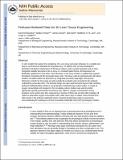Perfused multiwell plate for 3D liver tissue engineering
Author(s)
Domansky, Karel; Inman, Samuel Walker; Serdy, James George; Dash, Ajit; Lim, Matthew H. M.; Griffith, Linda G.; ... Show more Show less
DownloadGriffith_Perfused multiwell.pdf (4.807Mb)
OPEN_ACCESS_POLICY
Open Access Policy
Creative Commons Attribution-Noncommercial-Share Alike
Terms of use
Metadata
Show full item recordAbstract
In vitro models that capture the complexity of in vivo tissue and organ behaviors in a scalable and easy-to-use format are desirable for drug discovery. To address this, we have developed a bioreactor that fosters maintenance of 3D tissue cultures under constant perfusion and we have integrated multiple bioreactors into an array in a multiwell plate format. All bioreactors are fluidically isolated from each other. Each bioreactor in the array contains a scaffold that supports formation of hundreds of 3D microscale tissue units. The tissue units are perfused with cell culture medium circulated within the bioreactor by integrated pneumatic diaphragm micropumps. Electronic controls for the pumps are kept outside the incubator and connected to the perfused multiwell by pneumatic lines. The docking design and open-well bioreactor layout make handling perfused multiwell plates similar to using standard multiwell tissue culture plates. A model of oxygen consumption and transport in the circulating culture medium was used to predict appropriate operating parameters for primary liver cultures. Oxygen concentrations at key locations in the system were then measured as a function of flow rate and time after initiation of culture to determine oxygen consumption rates. After seven days of culture, tissue formed from cells seeded in the perfused multiwell reactor remained functionally viable as assessed by immunostaining for hepatocyte and liver sinusoidal endothelial cell (LSEC) phenotypic markers.
Date issued
2010-01Department
Massachusetts Institute of Technology. Department of Biological Engineering; Massachusetts Institute of Technology. Department of Mechanical EngineeringJournal
Lab on a Chip
Publisher
Royal Society of Chemistry
Citation
Domansky, Karel, Walker Inman, James Serdy, Ajit Dash, Matthew H. M. Lim, and Linda G. Griffith. “Perfused Multiwell Plate for 3D Liver Tissue Engineering.” Lab Chip 10, no. 1 (2010): 51.
Version: Author's final manuscript
ISSN
1473-0197
1473-0189